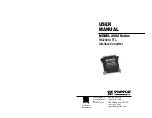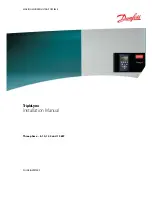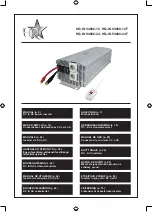
OPERATION
General Information
Before operating, performing maintenance or
repairing the Long Reach Scaler this manual
must be read and understood by the operator,
if in any doubt, ask your supervisor before
using this equipment.
Local safety regulations must be followed at
all times. Failure to follow these instructions
could result in damage to the Scaler and/or
personal injury.
Trelawny SPT Limited disclaims all
responsibility for damage to persons or
objects arising as a consequence of incorrect
handling of the tool, failure to inspect the tool
for damage or other faults that may influence
the operation prior to starting work, or failure
to follow the safety regulations listed or
applicable to the job site.
The tool is primarily designed for the removal
of workshop soiling, solidified paint spills,
carpet and ceramic tile removal, heavy rust,
and scale, concrete splashes and ; it can also
be used for the removal of laitance from
concrete.
This tool must not be used in a fixture.
This tool can be purchased in either Needle
Scaler or Chisel Scaler versions, with an
adaptor available for converting from one
version to another. It can be used both
indoors and out.
Air Supply
The compressed air must be free from water
and dirt. The installation of a filter/regulator/
lubricator air preparation set (with moisture
trap) adjacent to the tool is
strongly
recommended
.
Always clear the air hose before connecting to
the tool. Ensure that no moisture
(condensation) is present in the air hose.
Ensure that a minimum 10mm (3/8”) bore air
hose is used and that all couplings are
secure, leak free and in good condition.
Limit the length of air hose to 10M (33ft).
Where extra length is necessary, for each
additional 15M (50ft) of air hose used, the
pressure drop is approximately 0.21bar
(3psi).
For safe and efficient operation the correct
operating pressure is 6.2bar (90 psi).
Do not let the operating pressure fall below
5.5bar (80p.s.i.) or rise above 6.9bar (100 psi)
absolute maximum.
Preferably, the compressor should be able to
supply a minimum of 2.8 L/s (6 cfm).
In particularly cold temperatures it is
recommended that a proprietary anti-freeze
lubricating oil is used.
Lubrication
Oil the tool daily before use. Put a few drops
of one of the following zinc free air tool
lubricants through the air inlet.
SHELL
S22 or R10
CASTROL
Hyspin ZZ32
See also the section on AIR SUPPLY for
further information and recommendations.
Safety
Always, read through these instructions first
before use.
Do-
Be aware that this tool is not electrically
insulated.
Wear Personal Protective Equipment
including safety goggles, footwear, ear
defenders and gloves. In some environments
it will be necessary to wear
facemasks or breathing apparatus.
Be aware that this tool can create dust and
flying debris.
Keep hands and clothing away from moving
parts.
Store this tool in a secure and dry
environment.
Be aware of others working around you.
Ensure that this tool is lubricated daily.
Always observe safe-working practices at
all times.
Do not-
Allow the tool to run unattended.
Modify this tool in any way, as this will
invalidate the warranty and could lead to
serious injury.
Allow the tool to run continuously whilst not in
contact with the surface being prepared.
Use the tool if you become tired, this can lead
to physical strain or injuries.
Hold the exposed chisel or needles whilst the
tool is in use, this could cause vibration
damage to the hands.
Use this tool in potentially explosive
environments.
Drag this tool by the air hose.
Use petrol (gasoline), thinners or any other
high flash point solvent to clean the tool.
Care must be taken to avoid damaging or
tripping over the trailing air hose.
Please note:
Unrestrained hoses can whip
dangerously if they become detached.
Risk of Hand-arm
Vibration injury
These tools may cause Hand-arm Vibration
Syndrome injury if their use is not adequately
managed.
We advise you to carry out a risk assessment
and to implement measures such as:
Limiting exposure time [i.e. actual trigger time,
not total time at work], job rotation, ensuring
the tools are used correctly, ensuring the tools
are
maintained
according
to
our
recommendations, and ensuring that the
operators wear personal protective equipment
[PPE] particularly gloves and clothing to keep
them warm and dry.
Employers should consider setting up a
programme of health surveillance to establish
a benchmark for each operator and to detect
early symptoms of vibration injury.
We are not aware of any PPE that provides
protection against vibration injury by
attenuating vibration emissions.
See ‘Specifications’ section for vibration
emission data.
Further advice is available from our Technical
Department.
We strongly advise you to visit the Health &
S afet y
E xec uti ve
we bsite
htt p://
www.hse.gov.uk/vibration This site provides
excellent advice and information on HAV and
it includes a Hand-arm Vibration Exposure
Calculator that is easy to use to work out the
daily vibration exposure for each of your
operators.
Starting work
Please note:
The carbon steel chisels or needles provided
with these tools are not intended for use in a
potentially explosive atmosphere.
Prior to operating the tool check: -
That all fittings are secure, free from leaks
and air hoses are in good condition
.
That the air pressure is correct for this tool
6.2 bar (90 p.s.i.).
Put a few drops of a recommended lubricant
into the air inlet of the tool.
To operate the tool, which is dependant on
the type of lever fitted, for those fitted with a
safety lever, first push thumb button forwards
and then for both styles of lever, pull the lever
towards the hand grip to start the tool, then
apply the Chisel or Needles to the surface
being prepared.
Note:
Several types of Chisel are available for
the Long Reach Chisel Scaler to suit the job in
hand, including Aluminium Bronze spark
resistant Chisels; a Needle Scaler Attachment
is also available.
See parts list for details.
Warning!
This tool will continue to run for a
few seconds after releasing the throttle lever;
it is recommended that the tool remains in
contact with the work surface until the air is
exhausted. Gloves and personal protective
equipment must be worn when using this tool.
(See previous section on Risk of Vibration
Injury). Care must be taken to avoid damaging
or tripping over the air hose. Maintain contact
with the work surface with sufficient pressure
to keep the tool from bouncing off the surface.
Handled correctly the Long Reach Scaler will
work quickly and efficiently.
To switch off, simply release the throttle
lever.
Safe use of this tool requires a solid stance
and secure foothold, the tool may be used in
other postures but care must be taken to
ensure the operator adopts a firm and stable
position. Excessive operator pressure will not
improve the tools efficiency but could cause
premature tool failure and increase operator
fatigue. It could also increase the vibration
emission level.
Never allow the tool to run continuously
whilst not in contact with the surface being
prepared.
Do not use the Scaler as a lever, if the Chisel
becomes embedded in the material, withdraw
and try again. Never allow the tool to run
continuously whilst not in contact with the
surface being prepared.
Содержание LR2
Страница 1: ...Long Reach Scalers Operation and Maintenance Manual www trelawnyspt co uk ...
Страница 2: ......
Страница 3: ......
Страница 6: ...SERVICE LAYOUT Standard Scaler ...
Страница 7: ...SERVICE LAYOUT Lite Scaler ...
Страница 10: ...NOTES ...
Страница 11: ...NOTES ...






























